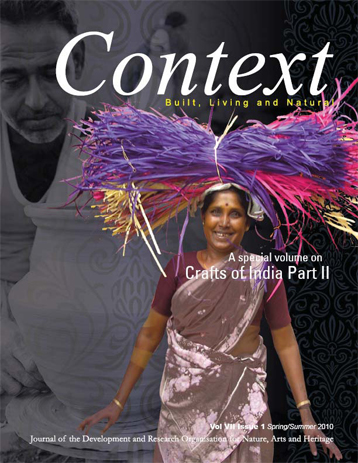Special Issue on Crafts of India Part 2: Volume VII Issue 1
About the Volume
Though the crafts of India are an integral part of the country’s cultural heritage and identity, we have yet to identify its economic potential as a national industry and as a tool for development. The recent government initiative of setting up a National Mission for the cultural and creative industries is a much needed and long-delayed step in this direction. However, much work remains to be done whether it be in undertaking a mapping exercise to understand the extent of this sector and the issues that it is ridden with, conserving cultural skills and knowledge, creating sustainable employment for crafts persons and artisans, disseminating craft skills or providing financial and legal support for this highly skilled but vulnerable section of society.
As part of our commitment to the revival of crafts, DRONAH presents two special volumes on ‘Crafts of India.’ The first volume contains a series of essays by various sectoral experts on a wide range of issues pertaining to the development and conservation of Indian crafts skills. Thus, the section titled ‘Crafting Futures’ discusses potential directions for policy development and the role of craft education and knowledge dissemination in creating an appropriate framework for development initiatives. ‘Access, Livelihood and Development’, showcases particular examples of successful design and market interventions in the crafts sector as well as highlights various issues that impede artisans’ access to sustainable income as well as working conditions. The ‘Redefining Craft’ section deals specifically with popular notions of what constitutes ‘craft’ and the manner in which such notions impact the economic value as well as aesthetic and intellectual appreciation of crafts objects and skills. Finally, the ‘Crafts and Environment’ section deals with the environmental impact of the crafts industry and contemporary experiments in environmentally sustainable models for the same.
The second volume specifically focuses on regional perspectives through the sections ‘Documenting Crafts’, ‘Crafts in Transition’, ‘Lessons from Creative Collaborations’ and ‘About Few Crafts’. It covers collaborations of crafts communities with designers, educationists and organisations with the aim of understanding the spectrum that is the Indian crafts sector in varied ways, as reflected in the experiences of organisations and institutions such as Dastkar, Dastkari Haat Samiti, Kala Raksha Vidhyalaya and Dakshinachitra.
The articles in these special volumes address some of the ironies and inconsistencies that plague the crafts sector of India. For instance, while ‘Dilli Haat’ is a benchmark initiative that acted as a catalyst for setting up similar regional and urban crafts centres across the country, traditional crafts clusters across the country (such as the Kumartuli settlement in West Bengal) which have become part of urban areas are now being included in the ‘slum improvement sector’ under the Jawaharlal Nehru National Urban Renewal Mission (JNNURM) scheme. It is apparent that all such urban developmental initiatives for the sector require a multi-disciplinary participation, with artisans, designers, entrepreneurs, NGOs, architects, urban planners and other stakeholders working together towards creating a practical framework and action plan. We hope these two volumes shall serve as a catalyst for just such a joining of forces!
Shikha Jain
Contents
A special volume on Crafts of India: Part II
About the Volume
Documenting Crafts
Jeypore Portfolio: Revival of traditional building crafts
Vanicka Arora
Thathera Craft of Jaipur
Ayush Kasliwal
Crafts in Transition
Crafts of Nagaland: Continuity and transformation
Kezochole Rhetso, Khate Kezo, Medosenuo Kesiezie
Sanganer: Traditional printing, modern challenges
Suki Skidmore
The Brass Work and Braziers of Hajo
Barnali Goswami
The Case of Bishnupur: Challenge of revitalising crafts
Somi Chatterjee and Jagan Shah
Papier Mache: A craft of Kashmir
M Saleem Beg and Hakeem Samir Hamdan
Lessons from Creative Collaborations
Learning from Crafts: Lessons in sustainable living
Aratrik Dev Varman
Leather Crafts in Kutch: The designer’s role
Anita Chandramohan-Kulkarni
History of Dakshinachitra: Preserving and promoting heritage
Deborah Thiagarajan
Kalaraksha Vidhyalaya: Designing a sustainable future
Judy Frater
About Few Crafts
Pottery: Traditions and variations
Ajit D Nagpurkar
Tonk Calligraphy
Kanika Gupta
Crafts of Karnataka
Indu Ramesh

